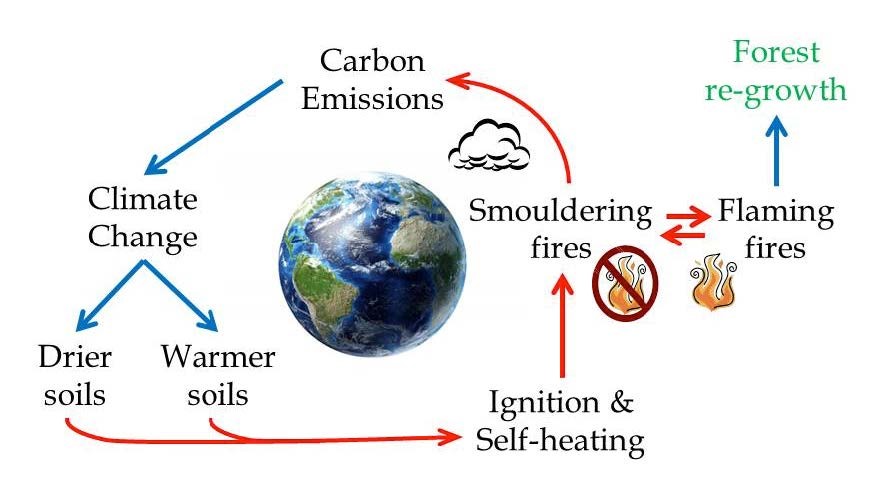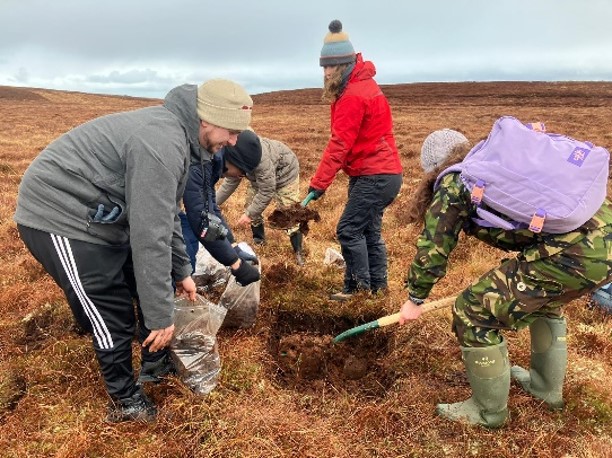High-latitude fires have the potential to shape the future of our climate in ways that we are currently incapable of predicting. Northern peatlands comprise the largest terrestrial carbon store, exerting a net cooling effect on the climate. However, as climate change is occurring most rapidly at high latitudes, the anticipated warmer and drier conditions are expected to heighten the vulnerability of carbon-rich peatlands to fire. Peat fires, which are considered the largest and most persistent fires on Earth, can significantly impact the global carbon cycle, atmospheric composition, climate, air quality, and human health, while feedback loops on climate change can also emerge (Figure 1).

Figure 1. Positive feedback loop between smouldering fires and climate change (Rein 2013)
Representing peatland fire feedbacks to climate in Earth System Models (ESMs) is essential for accurately predicting the future of the climate system. Nevertheless, despite the urgency of the problem, largely, current ESMs lack peat fire and emissions capabilities.
A first approach to address this issue has been made by our Centre member Dr. Katie Blackford. Dr Blackford developed INFERNO-peat, the first parameterization of peat fires in the JULES-INFERNO (Joint UK Land Environment Simulator INteractive Fire and Emission algoRithm for Natural envirOnments) fire model. Initial simulations are very promising as compared to Global Fire Emissions Database version 5 (GFED5), INFERNO-peat captures ∼ 20 % more burnt area, whereas INFERNO underestimated burning by 50 % (Figure 2).

Figure 2. Average annual burnt area fraction (2010-2014) (Blackford et al., 2024)
This project, which is funded by the AXA Research Fund (AXA Chair in Wildfires and Climate) and the A.G. Leventis Foundation Educational Grant, and also supported by Leverhulme Wildfires, aims to further develop INFERNO-peat. A holistic approach that combines field research, cutting-edge lab experiments and real-time observational data is used to better quantify the impacts of wildfires on climate. Since peat moisture content and the resulting depth of burn have been experimentally proved to be critical for the representation of peat fires, we aim to incorporate those mechanisms into a further advanced global model functionality.
In close collaboration with Prof. Guillermo Rein (Imperial Hazelab), an expert in the field of smouldering combustion, and his world-leading team, a field trip in Thurso (Northern Scotland) for peat collection took place in March 2024 (Figure 3), and a series of experiments are currently being conducted in the lab, providing valuable information on how peat’s properties influence the ability of a peat fire to self-sustain, or otherwise to become extinct (Figure 4).

Figure 3. Collecting peat from a natural peatland

Figure 4. Experimental set-up in lab-scale
This study will develop the first peatland and thawing permafrost burning modelling capability for ESMs that is solidly based on emerging mechanistic understanding from the lab. It is expected to be a breakthrough in the understanding of how wildfires affect the climate system, with implications for climate services and policy.
Duration: 2023-2026
References
Rein, 2013, “Smouldering fires and natural fuels”, Phenomena and the Earth System, Belcher (Ed.), Wiley and Sons, 15–33, https://doi.org/10.1002/9781118529539.ch2
Mangeon et al., 2016, “Inferno: A fire and emissions scheme for the UK Met Office’s unified model”, Geosci. Model Dev., 9(8), 2685–2700, https://doi.org/10.5194/gmd-9-2685-2016
Blackford et al., 2024, “INFERNO-peat v1.0.0: A representation of northern high latitude peat fires in the JULES-INFERNO global fire model”, Geosci. Model Dev., 17, 3063–3079, https://doi.org/10.5194/gmd-17-3063-2024, 2024
Huang and Rein, 2017, “Downward spread of smouldering peat fire: the role of moisture, density and oxygen supply”, Int. J. Wildland Fire, 26(11), 907-918, https://doi.org/10.1071/WF16198










